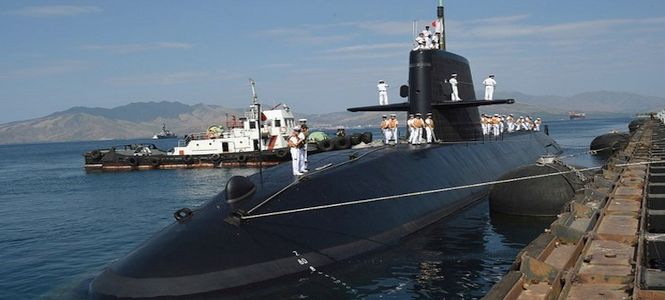
Japanese submarine Oyashio docks at a port of the former US naval base in Subic bay
by Mohan Das Menon
Given the competing aspirations of the numerous nations involved in disputes over territorial claims and counter-claims in the South China Sea and the accelerating level of tensions, a new engaging arena in power play could draw global focus. With the emerging possibility of fresh escalation in regional tensions, national security apparatuses round the world should be looking for options to avert any major military conflict sprouting from it.
Vietnam last week became the latest country to get embroiled in a potential stand-off with China over fishing in its waters when it seized a Chinese ship with three people on board in the Gulf of Tonkin near the South China Sea.
This came as a Japanese submarine, escorted by two guided-missile destroyers, arrived in the Philippines on April 2 ahead of annual military exercises between the Philippines and the US meant to be a show of strength amid China’s increasing assertiveness in the South China Sea.
The 70-man Oyashio is the first Japanese submarine to visit the Philippines in 15 years. One of the Japanese Maritime Self-Defence Force’s newest and largest submarines, it docked at Subic Bay, a former US military base, 130km north of Manila. It was escorted by the Murasame-class Ariake and Asagiri-class Setogiri destroyers.
In the overall context of an excessive Chinese diplomatic thrust on projecting “Claim Area Propositions” is to cover up intrusive forays by Chinese state supported fishing vessels into maritime zones of other countries. Beijing has suddenly come out with a specious logic of existence of “traditional Chinese fishing grounds” in the heart of Indonesia’s territorial waters.
Jakarta, however, reacted fast and furiously. In an incident that took place on March 21 this year, Jakarta lodged a strong protest with the Chinese embassy in the Indonesian capital, claiming that the intrusion of a Chinese vessel into clearly mandated Indonesian waters was untenable.
Beijing, a signatory to the UN Convention on the Law of the Sea (UNCLOS), ought to have realised that its illusory justification made no logic as the intruding Chinese vessel was just about four kilometres off the Natuna Islands and within the 12 nautical mile of Indonesian maritime border perimeter. Under such circumstances, perhaps for the first time, Indonesia and China now have a boundary dispute considering that nearly a dozen Chinese seamen who transgressed these limits are now in Indonesian custody.
Significantly, the other contenders to portions of the Paracel and Spratly Islands, including Vietnam, Philippines, Malaysia, Brunei and Taiwan are also somewhat alarmed that the Chinese strategy aimed at the gradual reclamation of ‘isle-space’ for military purposes would eventually tilt the balance irremediably in Beijing’s favour.
According to ASEAN diplomatic quarters in Singapore, recent incidents reflected Chinese aggressive intensions which are bound to lead to hardening of positions by other stakeholders in disputed maritime zones of Asia.
Indonesia will deploy US-made F-16 fighter jets to the Natuna islands to ward off “thieves”, its defence minister Ryamizard Ryacudu said after Chinese coast guard vessels clashed with an Indonesian boat in the area. The move is part of a military buildup on islands overlooking the South China Sea that will see a refurbished runway and a new port constructed, said in an interview to an international news agency. It also involves the deployment of marines, air force special force units, an army battalion, three frigates, a new radar system and drones, he said.
The stationing of five F-16s reflects a new level of Indonesian concern about territorial disputes in the South China Sea that are pitting Beijing against several of its Southeast Asian neighbours. Indonesia is not a claimant, but the clash with the Chinese coast guard last month over the detention of a Chinese fishing boat showed the potential for it to be drawn into conflict.
“Natuna is a door; if the door is not guarded, then thieves will come inside,” said Ryacudu, a former army chief of staff. “There has been all this fuss because until now it has not been guarded. This is about the respect of the country.”
China’s tactics and strategies countering regional and global dynamics of power blocs need to be prudently interpreted amid apprehensions of its own possible comparative isolation within the region.
Historically, South China Sea has been in dispute between China and eight other countries in this region, including Vietnam, Malaysia, the Philippines and Brunei. The situation, however, has never been so alarming as it has now become in recent times. India must take a serious notice of the recent tension in the South China Sea as about 50 per cent of Indian trade transits through it. It is important for India to ensure that there is absolute freedom of navigation in this part of the world. While India’s relations with the ASEAN have improved since the 1990s, it has assumed added significance under the Modi government’s ‘Act East’ Policy in view of the fact that India views ASEAN countries—some of them involved in the South China dispute—as playing a crucial role in its economic development.
Menon is a former additional secretary, Government of India